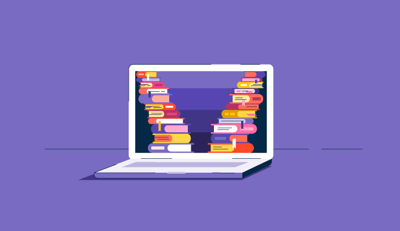October 25, 2024
 by Jordan Wahl / October 25, 2024
by Jordan Wahl / October 25, 2024

For many writers, the journey from writing a book to publishing is a rollercoaster of challenges.
Earlier, authors printed a myriad of manuscripts and sent them to each book publisher. Then came the cooling time between the manuscript submission and publisher review, which led to writer stress, rejection, publishing costs, and demotivation.
But now, authors don't have to worry about these challenges anymore. By uploading manuscripts via flipbook software, they can create eBooks, connect with book suppliers, and publish their work comfortably.
Pick up that discarded copy and learn how to publish your eBook to make your voice feel heard.
To publish an eBook, you need to follow this eight-fold process:
Let's look at how modern-day authors publish their eBooks without juggling traditional obstacles and reducing rollbacks of manuscripts.
Below, we’ll walk through how to go about publishing with the top four eBook retailers in the industry: Amazon, Apple, Nook, and Kobo.
If you’re trying to reach the widest audience, Amazon is the place to start. Amazon has dominated eBook sales throughout the past decade and has become one of the largest eBook retailers in the industry with its publishing platform, Kindle Direct Publishing, which is meant for talented authors and poets.
In order to publish with KDP, your eBook file needs to be exported in .asw or .mobi file formats, also known as Kindle files. To get started, you’ll have to either sign in with your Amazon account or sign up for an account if you don’t already have one. Once you’ve signed in, be sure to read the terms and conditions before beginning the publishing process to ensure you understand royalties, payments, distributions, etc.
With Kindle Direct Publishing, you have two eBook royalty options: there is a 35 percent royalty option or an option of up to 70 percent royalty on sales in select American and European countries. To incentivize authors to work exclusively with Kindle Direct Publishing, Amazon offers KDP Select, a program that grants you access to a new set of promotional tools.
To write and sell your novels with Amazon KDP, the first step is to prepare your manuscript as a compatible soft copy and align it with Amazon's publishing guidelines. Once you have a compatible and properly formatted document, you can explore other options, like adding DRM, watermark, intellectual property coverage, and so on.
Apple’s eBook publishing platform, iBooks Author, comes in second to Amazon. iBooks Author is a free macOS app (available in the app store or on a Mac) that can be used to create and publish eBooks. This app has templates, layout tools, and image galleries available that enable authors to create media-rich, interactive eBooks that can be viewed with any Apple device that has the Apple Books app.
To publish from iBooks Author, you will need to export your file as .pdf, .txt, .epub, or iBooks file. If you are looking to create an eBook in iBooks Author, you can create it in an EPUB (.epub) or iBooks (.ibooks) format and publish your work directly to the iBooks Store.
In order to sell your book on the iBooks Store, you’ll have to set up iTunes Connect for iBooks and download iTunes Producer, and your eBook must be in iBooks (.ibooks) file format. You can also sell your book on the web, but it must be in a non-iBooks file format, such as EPUB or PDF.
Unlike Amazon and Apple, Barnes & Noble’s sales have declined in recent years, but that doesn’t mean that it’s not a major player in the eBook industry. In order to use Barnes & Noble’s publishing platform, Barnes & Noble Press (formerly known as NOOK Press), you’ll need to sign up for an account on its website. From there, you can easily create, publish, and promote your eBook.
Barnes and Noble have liaisons with third-party publications and retailers who contact authors and facilitate the eBook process for them. However, getting work published with Barnes and Noble can incur a decent fee—or publishing cost.
To publish with Barnes & Noble Press, you can upload a doc or docx, txt, rtf, HTML, or EPUB. The NOOK store sells EPUBs, so if you upload something other than an EPUB, Barnes & Noble Press will convert your document to an EPUB file.
In addition to creating and publishing your eBook, Barnes & Noble Press offers resources to help you sell your eBook. From marketing advice and tips to exclusive merchandising programs, Barnes & Noble Press helps drive awareness and sales.
For a step-by-step tutorial on publishing your eBook with Barnes & Noble Press, check out this article.
Kobo is the smallest of the major retailers, but don’t underestimate the company’s value. It’s slowly but surely growing and has an international presence. Kobo’s self-publishing portal, Kobo Writing Life, allows authors and publishers to easily create, edit, and publish content to its eBook stores around the world.
To start publishing with Kobo Writing Life, you can upload your content in a file in DOC, DOCX, EPUB, MOBI, or OPF. Kobo uses EPUB files, so if your file isn’t already in this format, it will be converted before it’s ready for publishing.
Kobo sells eBooks in well over 150 countries every month, and its global expansion continues. Depending on the price of the eBook and the territory in which it is sold, Kobo vendors can receive up to 70 percent royalty on eBook sales.
Wiley offers online publishing services for authors to create a lasting impression and inspire other budding authors and writers. The process of book creation and publication is seamless and straightforward, and Wiley offers personalized assistance throughout the entire pipeline.
Wiley is known to be one of the most prominent names in academic, fiction, non-fiction, and other genres of books. The writers have to work on a mandatory proposal to the editor, stating the epilogue and preface of their manuscript. This is more like a discipline-oriented stage of the entire process, where writers are willing to seek review and editor's feedback on the manuscript. The letter of proposal has to follow a checklist that encapsulates the "basics", "what "why", "who", and "how" of your manuscript. Submitting it directly via the Wiley publishing service platform is the first step.
Then, the author needs to submit the proposal and wait for the cooling period. The user should also specify the genre of their work and the target market. There are two categories: academic and professional publishing and trade and general publishing. After that, authors need to prepare and submit a copy of their manuscript.
Wiley sends the manuscript for quality and content review before rolling it into their printing production. The final edition is managed by a typesetter who digitizes the book in different formats and also sends it for offline physical binding. After your publication cycle is complete, Wiley also supports authors to hold book signing and book promotion campaigns.
Whether you’ve set out to write a personal eBook or an eBook as part of your marketing strategy, writing one can be fairly simple if you approach it the right way.
is the expected revenue that the eBook market will generate in 2024 at an annual growth rate of 1.62%
Source: Statista
In order to have a successful eBook, you need to have great content and make that content look appealing. If you don’t, people won’t even make it to your content, no matter how awesome it is. So, here are a few things to keep in mind while designing your eBook cover:
Converting your eBook into eBook file format is an extremely important step when publishing an eBook because it ensures that your content isn’t edited and is actually readable.
Depending on what type of eBook you’re writing, there are several formats that you can choose from. While there are actually dozens of potential eBook formats, I’m going to touch on the five most commonly used and widely distributed formats: TXT, EPUB, MOBI, AZW, and PDF.
Choosing the right format is crucial because it determines who you are writing the book for and which medium to use for audience engagement. Also, building paperless eBooks or paperbacks is an indication of the structure of your eBook (like plain, image-based, or graph-based).
Many authors make the mistake of choosing a file format before considering any of these things. What they don’t know is that some file types are better for different types of content, some file types aren’t compatible with certain devices, and retailers have specific file type requirements as well (which I’ll cover afterward). So, failing to acknowledge these variables could lead to trouble in the publishing process.
For more clarity on finding the right eBook file format, I recommend learning more about e-book formats and how to choose the best one for you.
Chances are you’re not going to let people read your eBook for free. Not after all of the blood, sweat, and tears you put into the darn thing. In order to earn that well-deserved cash, you’ll have to price your eBook. Unfortunately, it’s not as easy as throwing out a number. There is a strategy behind making a well-informed decision.
While there are several factors that should be considered when pricing your ebook, including delivery costs and your eBook’s length, quality, and genre, there is one that I find predominant: royalty percentages.
Book royalties are a percentage of the eBook’s retail price. This percentage changes depending on the retailer and list price. To illustrate how royalties vary, I’ve included this chart that indicates what percentage of the price you would receive. (Note: These are examples only. The other factors I mentioned above would affect actual royalties.)

Confused? Let’s walk through an example.
Say your book is on Amazon for $5.99 with a 70 percent royalty. This means you’d receive $4.19 of that $5.99. At the same price, you’d receive $4.19 from the iBookstore sale, $3.89 from a Barnes & Noble sale, and between $2.40 and $3.29 from other retailers.
If you decide to distribute through multiple retailers, you have to agree to sell the eBook for the same price on all platforms. Don’t “work the system” to make up for royalty percentage differences.
As shown in the chart above, most major retailers provide the highest royalties for eBooks priced between $2.99 and $9.99. So, I’d suggest aiming for this price range. Remember, because you’re self-publishing, you can adjust your price if you find it isn’t working for your goals.
If you recall, I did mention that you probably aren’t giving your eBook out for free. But, there is one exception: marketing. In marketing, eBooks are generally not distributed for revenue purposes but rather with the goal of attracting new business (i.e., collecting email addresses as potential leads). Although that business doesn’t include you directly receiving a monetary payment for your eBook, you are, in turn, reaping the long-term benefits of growing your business.
Before starting the publishing process, you’ll need to consider who you want to publish with. There are two options you can open yourself to. Either hire a book aggregator to format, print, publish, and distribute eBooks across book sites. Or, do it yourself while handling production costs and supply chain relationships to self-publish a book.
What’s the difference, you ask?
Authors can consider two ways: either supply their manuscript to a wholesale book aggregator to automate the book distribution process or simply take the steering.
-png.png?width=600&height=375&name=image%20classification%20vs-%20object%20detection%20(6)-png.png)
An eBook aggregator, sometimes called a distributor, acts as the middle-man in the publishing process. In other words, they deal directly with the eBook authors for publishing and then coordinate with eBook retailers, like Amazon and Apple, to move forward with distributing the eBook. You might consider using an eBook aggregator in the case that you don’t meet the requirements to self-publish (i.e., Barnes & Noble requires you to have a U.S. bank account and U.S. Tax ID) or if you simply don’t have the hardware or technical expertise to format and publish your eBook.
Sure, eBook aggregators can take some weight off your shoulders and do the work for you, but their service does come with a price. They generally provide additional services, like sales reporting, in addition to the actual publishing and distribution. But they make money by taking a share of your royalty or sales.
DIY Self-publishing is a less stress-inducing encashment stream if authors don't want to pay book aggregators or wholesalers. Doing it yourself without the profit share of aggregators can familiarize you with the self-publishing process and not burn out your royalties or sales.
The self-publishing production workflow has become easy with the presence of top renowned eBook publishers like Lulu, Amazon KDP, Barnes and Noble, HarperCollins, and other renowned book sites. The platform automates manuscripts into an accessible electronic file format and works with a pre-installed JavaScript and HTML framework to upload the soft copy to the publishing website. Further, authors can personalize and design their own book covers and paperbacks without accounting for design agency fees.
Now that you know your publishing options, it’s time to choose which one is right for you. While making your decision, set the context of your research. This involves checking out all the easy and cost-efficient streams, book suppliers and distributors, expenditures, and end profits that you'll earn as a cut.
If you decide to go the direct self-publishing route, that would be awesome. Below are the top eBook retailers in the industry. In other words, the names of every store you’ll want to publish your eBook on.
Now, let me walk you through the self-publishing process.
To publish your eBook, you’ll need more than just the content itself. Each retailer will require information regarding your eBook before publishing it. Although these may differ by platform, here is a list of general information to have ready before publishing:
Once you have the information above prepared, you’re ready to start the publishing process.
Now that you’ve published your eBook don’t forget about one of the major reasons you published it in the first place (aside from marketing): revenue!
Unfortunately, you can’t just publish your eBook and call it a day. Your book won’t market and promote itself. Plan to put in time and effort to make sure that people not only see your eBook but also read it.
Here are three ways to increase your eBook sales instantly:
Putting all your eggs in one basket is a bad idea. If you want to maximize your reach and increase sales, plan to sell your eBook through various retailers globally. We discussed how to publish with the big players in the industry above (Amazon, Apple, Barnes & Noble, and Kobo), but that doesn’t mean additionally publishing with smaller retailers in the industry is bad. Check out smaller retailers like Scribd, Baker & Taylor, and Gardners to explore more options for book production outsourcing.
How do you guide your audience to your eBook? You build a strong web presence, which requires a combination of tactics.
If you focus your efforts on tactics similar to those above, you’ll quickly build a strong web presence, reel your audience in, and increase eBook sales.
Nowadays, people hesitate to purchase something without first getting a second opinion. With that, if your eBook doesn’t have at least a few customer reviews, you’re going to have a tough time getting people to buy it. To avoid this, you’ll want to find ways to get to get readers to leave a review. Word-of-mouth can be one of your most powerful tools, so put effort into getting readers to generate a buzz about your eBook!
With that, it’s time to publish your eBook. If you have a rough manuscript being marinated in dust and soot, brush it off and get to work today. Digitizing your manuscript and publishing your first eBook isn't a far-fetched dream anymore. With the advancements in technology, creative media, and globalization, the podium is given to talented authors and writers to publish books and empower others with their mighty desk names ubiquitously.
If this sounds familiar to you, write that book and own up to self-publishing your work in your expertise and zone of genius today! Break all the barriers and stereotypes and become a renowned and published author without any ado.
Print your book with a creative repository of front and back-page designs and explore digital upload flexibility with desktop publishing software.
This article was originally published in 2018 and has been updated with new information.
Jordan Wahl is a former content manager at G2. She holds a BBA in Marketing from the University of Wisconsin-Whitewater. She loves anything that puts her in her creative space. including writing, art, and music.
If you’re serious about turning content into a pipeline, an eBook is one of the most effective...
.png) by Tanuja Bahirat
by Tanuja Bahirat
So if I’m guessing correctly, you’re here because you’ve decided to learn how to make an...
 by Jordan Wahl
by Jordan Wahl
As more readers turn to digital devices for their reading experiences, ebooks have become an...
 by Jordan Wahl
by Jordan Wahl
If you’re serious about turning content into a pipeline, an eBook is one of the most effective...
.png) by Tanuja Bahirat
by Tanuja Bahirat
So if I’m guessing correctly, you’re here because you’ve decided to learn how to make an...
 by Jordan Wahl
by Jordan Wahl

